Earth Science
What Is Earth Science?
Earth Science studies the components that make up the earth, including the surface of the earth and everything that lies beneath it, as well as the atmosphere that adheres above the earth's surface.
By understanding the earth better, we are able (in theory) to predict change and manage the earth better.
An understanding of the earth is critical to many industries:- from mining to farming, and town planning to event planning.
Understanding the Atmosphere
 The atmosphere is composed of a mix of moisture, temperature and gases which, in one way or another, control the conditions that are vital for the occurrence of life on earth. These conditions are always, somewhat, active and are subject to change at every moment in time. The variations in the atmosphere along with the earth’s energy dynamics play a major role on what influences an everyday environmental behaviour. This, along with the movement of the earth and the suns radiation, produces continuous and aggregate conditions of climate and weather phenomenon’s that affect, positively or negatively, life on earth.
The atmosphere is composed of a mix of moisture, temperature and gases which, in one way or another, control the conditions that are vital for the occurrence of life on earth. These conditions are always, somewhat, active and are subject to change at every moment in time. The variations in the atmosphere along with the earth’s energy dynamics play a major role on what influences an everyday environmental behaviour. This, along with the movement of the earth and the suns radiation, produces continuous and aggregate conditions of climate and weather phenomenon’s that affect, positively or negatively, life on earth.
Weather, therefore, can be understood as a constant change of the atmospheric state at a certain time and place; whereas, climate can be defined as the aggregation of weather patterns throughout a certain amount of time (e.g. years) at a certain place or region.
Different parts of the earth receive different intensity of radiation due to the earth’s spherical shape. One specific part of the surface of the earth receives solar radiation at a ‘right angle’ (90°), which is when the sun is at its closest point to the object (above head); when the sun is at this angle it is also referred to as ‘zenith’. When the sun is at its longest distance with the point or object, then it is said that the sun is in the ‘horizon’. At night there is no more solar radiation coming in, however, the outgoing radiation continues, which means there is a loss of energy from the earth back into space rather than the gain of energy that occurs during the day. In regards to day/night radiation as well as the position of the sun in relation to the earth, we can say that in equatorial regions there is a net gain of energy from radiation, whereas in the Polar Regions there is a net loss of energy from radiation. However, because the universe is always searching for balance, the excess energy or heat (warm air) in the equator is transferred and replaced by cool air through a process called ‘advection’. The temperature in this area cools down, while the temperature in the Polar Regions warm up.
The effect of the solar radiation that is absorbed will undoubtedly depend on the depth the heat travels through the substance or surface it is hitting, as well as the ‘heat capacity’ (i.e. the amount of heat required to change a mass unit of a substance by 1°C) each particular substance has. In other words, if the heat capacity (or specific heat) of a substance is low, then that means there is less energy required to raise the temperature of one unit of mass. For example: Sand is a poor heat conductor with low specific heat, therefore, it will receive some solar radiation, however, this will vary from object to object because darker sand will absorb more heat than light-coloured sand. Another example can be explained with snow, which is capable of lasting longer periods of sunny weather due to the fact that it has low absorption rate of solar radiation.
Understanding Rain
On a global scale, the amount of precipitation occurring on different regions is influenced by presence of low or high pressure systems. This way, regions subtle to high pressure and diverging winds will generally be associated with dry weather conditions (e.g. regions with continuous presence of sub-tropical highs such as the Sahara and Kalahari desert or the dry lands in Australia, United States and Canada), while areas influenced by low pressure cells, converging winds and rising air (e.g. regions closer to the equator such as the tropical rainforests in Brasil and Africa - Amazon, Congo) are most likely to receive great amounts of precipitation.
However, not only prevailing winds and pressure systems stimulate the amount of rainfall occurring over different areas, but air composition (warmer air has a higher capacity for sustaining moisture than colder air), temperature, land and water are also main factors that can greatly contribute to precipitation variations. For example, large landmasses around the mid-latitudes receive less rainfall than areas of land surrounded by the coast in the same latitudes.
Studying Earth Science
We offer a 100 hour distance education course on Earth Science designed to develop your knowledge of the physical characteristics and dynamics of the earth, oceans and global atmosphere. Understand more about how the world is formed and how different elements interact.
Knowing more about the planet is valuable knowledge for a range of different career roles, from environmental research to technical and freelance writers.
Earth Science has been developed and is tutored by highly knowledgeable Environmental tutors. Get in touch with our Environmental specialists today - find out what routes of study you can take to achieve your goals.
[16/12/2025 20:35:36]
More from ACS
Short courses, certificates and diplomas -lots of home study options.
Short courses, certificates and diplomas - dozens of unique study options